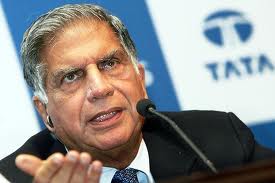
New Delhi, July 19: Tata group Chairman Ratan Tata has said that Prime Minister Manmohan Singh must restore government credibility and place the country on a growth path once again by implementing promised reforms.
The Chairman of the USD 100 billion conglomerate has also hit out at the Opposition, media and "some members of ruling party", saying it is "grossly misdirected" to single out the Prime Minister and blame him for the economic woes that the country is facing at present.
"Now is the moment in time our Prime Minister must break convention, restore government credibility, place the country on a growth path once again by implementing promised reforms, removing roadblocks to growth and controlling crony capitalism," Tata tweeted.
He said "government action has been too little too late" as India has lost growth momentum over the past 12 months with investment confidence declining and inflation soaring.
"...but to single out and blame the Prime Minister is grossly misdirected," Tata tweeted, saying he was "depressed to see the attacks on India" and "felt obliged to express my feelings".
Throwing his weight behind Singh, Tata said: "It is sad and unfortunate that in the past few months the Opposition, the media, some private citizens and even some members of the ruling party have mercilessly spoken and written about our Prime Minister -- a person who was the architect of the '91 reforms, which brought economic prosperity and international recognition to our country."
They have also chosen to overlook the fact that this warm-hearted Prime Minister has led our country with great personal dignity and integrity, Tata added.
Instead, Tata said: "We should also recognise the enormous damage done by political infighting; the single minded goal of the Opposition to topple the government; the allegations, accusations of corruption of illegal acts which have brought almost all government action to a standstill."
Turning his ire to the media, Tata said: "We should be concerned about unconfirmed sensationalised stories in the media to sell publications..."
Recently, the 'Time' magazine had termed Singh as an "underachiever", while UK-based 'The Independent' had wondered if he was "India's saviour or Sonia's poodle".
Tata also said the country must be concerned about "the manipulation of policy by power brokers and vested interest groups to meet their self serving desire to continue protection".
Asking Indians to support Singh, Tata said: "He deserves the support of the people of India at this critical time. All eyes are on him here and overseas in what could be his 'finest hour' in leading the country to economic prosperity again. He will need to act boldly, to be courageous and to do "the right thing".
"For the sake of the country, we all hope he will," Tata said.





Comments
Add new comment